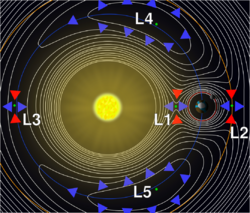Astronomy:2020 XL5
| Discovery [1][2] | |
|---|---|
| Discovered by | Pan-STARRS 1 |
| Discovery site | Haleakala Obs. |
| Discovery date | 12 December 2020 |
| Designations | |
| 2020 XL5 | |
| P11aRcq [3][4] | |
| Minor planet category | Earth trojan[5] · NEO Apollo [6] |
| Orbital characteristics [6] | |
| Epoch 31 May 2020 (JD 2459000.5) | |
| Uncertainty parameter 7 | |
| Observation arc | 43 days |
| Earliest precovery date | 26 November 2020 |
| |{{{apsis}}}|helion}} | 1.389 AU |
| |{{{apsis}}}|helion}} | 0.6133 AU |
| 1.001 AU | |
| Eccentricity | 0.38729 |
| Orbital period | 1.00 yr (365.78 d) |
| Mean anomaly | 85.797° |
| Mean motion | 0° 59m 3.148s / day |
| Inclination | 13.849° |
| Longitude of ascending node | 1.808° |
| |{{{apsis}}}|helion}} | 4 March 2020 19:51 UT |
| 153.608° | |
| Earth MOID | 0.07593 AU (11,359,000 km) |
| Venus MOID | 0.02730 AU (4,084,000 km)[2] |
| Physical characteristics | |
| Mean diameter | 250–550 m (assumed albedo 0.05–0.25)[7] |
| Apparent magnitude | 21.8 (current)[8] 21.4 (at discovery)[1] |
| Absolute magnitude (H) | 20.164±0.470[6] 20.18[2] |
2020 XL5 is a sub-kilometer near-Earth asteroid and suspected Earth trojan discovered by the Pan-STARRS 1 survey at Haleakala Observatory, Hawaii on 12 December 2020. In a corotating reference frame with Earth, 2020 XL5's path oscillates about the Sun–Earth L4 Lagrangian point (leading 60°), one of the dynamically stable locations where the combined gravitational force acts through the Sun's and Earth's barycenter. Analysis of 2020 XL5's trojan orbit stability suggests it will remain around Earth's L4 point for several thousand years until gravitational peturbations by Venus destabilize its trojan configuration. It is considered the second Earth trojan discovered, after 2010 TK7 in 2010.[5]
Discovery
2020 XL5 was discovered by the Pan-STARRS 1 survey at Haleakala Observatory, Hawaii on 12 December 2020. It was first observed in the constellation Crater at an apparent magnitude of 21.4.[1] The asteroid was moving at an on-sky rate of 3.02 arcseconds per minute, from a distance of 0.68 AU (102 million km; 63 million mi) from Earth.[9]
The asteroid was subsequently listed on the Minor Planet Center's Near-Earth Object Confirmation Page (NEOCP) as P11aRcq.[4] Over two days, follow-up observations were carried out by the Višnjan Observatory (L01), ESA Optical Ground Station (J04), and Cerro Tololo Observatory (807). The asteroid was identified in earlier Mount Lemmon Survey (G96) observations from 26 November 2020. The listing was confirmed and publicly announced as 2020 XL5 on 14 December 2020.[1]
Orbit and classification
Having been observed for only 43 days, the orbit of 2020 XL5 has significant uncertainty with a condition code of 7.[2] Additional observations over several oppositions are necessary to constrain its orbit over the long-term.
2020 XL5 orbits the Sun at an average distance of 1.001 AU once every 365.78±0.14 days, or approximately 1 Earth year. Its orbit has a high eccentricity of 0.388 and an inclination of 13.8° with respect to the ecliptic plane. Over the course of its orbit, its distance from the Sun ranges from 0.61 AU at perihelion to 1.39 AU at aphelion, crossing the orbits of Venus and Earth. Since its orbit crosses that of Earth's while having a semi-major axis greater than 1 AU (by a small margin), 2020 XL5 is classified as an Apollo asteroid.[6]
Trojan orbit

Trojan objects are most easily conceived as orbiting at a Lagrangian point, a dynamically stable location (where the combined gravitational force acts through the Sun's and Earth's barycenter) 60 degrees ahead of (L4) or behind (L5) a massive orbiting body, in a type of 1:1 orbital resonance. In reality, they oscillate around such a point.[5]
On 26 January 2021, amateur astronomer Tony Dunn reported that 2020 XL5's nominal trajectory appears to be librating about Earth's leading L4 Lagrangian point, suspecting it to be an Earth trojan.[5] Subsequent analysis confirmed modeling stability for at least several thousand years into the future based on existing orbital parameters.[10] This would make 2020 XL5 more stable than the prototype L4 Earth trojan 2010 TK7, which is potentially unstable on timescales of less than 2,000 years.[11] A comparison between the dynamical evolutions of these two objects confirms the conclusions obtained on Earth trojan 2010 TK7 but shows that the available data for 2020 XL5 are not robust enough to confirm its trojan nature, although the current nominal orbit of this object displays short-term trojan behavior (significantly shorter than that of 2010 TK7).[12]
2020 XL5's high orbital eccentricity results in wide, tadpole-shaped oscillation paths in a corotating reference frame with Earth and its Lagrangian points. Although the asteroid crosses Venus's orbit with a minimum orbit intersection distance (MOID) of 0.0273 AU (4.1 million km; 2.5 million mi),[2] perturbations by the planet are currently negligible since its nominal orbit brings it either too high or too low from the plane of Venus's orbit.[13] Venus's influence on 2020 XL5's orbit will become greater over time as their longitudes of the ascending node precess over hundreds of years, lowering 2020 XL5's Venus MOID and eventually destabilizing its trojan orbit by sending it to Earth's L3 point in several thousand years.[13]
Physical characteristics
Based on an magnitude-to-diameter conversion and a measured absolute magnitude of 20.16, 2020 XL5 measures between 250 and 550 meters in diameter for an assumed geometric albedo of 0.25 and 0.05, respectively.[7] Its absolute magnitude is slightly smaller (thus brighter) than that of 2010 TK7 (20.8),[14] implying that 2020 XL5 likely has a slightly larger diameter if it is assumed that both have the same geometric albedos.[5] This makes 2020 XL5 likely the largest known Earth trojan to date.
See also
References
- ↑ 1.0 1.1 1.2 1.3 "MPEC 2020-X171 : 2020 XL5". Minor Planet Electronic Circular. Minor Planet Center. 14 December 2020. https://minorplanetcenter.net/mpec/K20/K20XH1.html.
- ↑ 2.0 2.1 2.2 2.3 2.4 "2020 XL5". Minor Planet Center. International Astronomical Union. http://www.minorplanetcenter.net/db_search/show_object?object_id=2020+XL5.
- ↑ "2020 XL5". NEO Exchange. Las Cumbres Observatory. 14 December 2020. https://neoexchange.lco.global/target/63044/.
- ↑ 4.0 4.1 Gray, Bill (14 December 2020). ""Pseudo-MPEC" for P11aRcq". Project Pluto. https://projectpluto.com/neocp2/mpecs/P11aRcq.htm.
- ↑ 5.0 5.1 5.2 5.3 5.4 Hecht, Jeff (4 February 2021). "Second Earth Trojan Discovered". Sky & Telescope. https://skyandtelescope.org/astronomy-news/second-earth-trojan-asteroid-discovered/.
- ↑ 6.0 6.1 6.2 6.3 "JPL Small-Body Database Browser: 2020 XL5". Jet Propulsion Laboratory. https://ssd.jpl.nasa.gov/sbdb.cgi?sstr=54100199;cad=1.
- ↑ 7.0 7.1 Bruton, Dan. "Conversion of Absolute Magnitude to Diameter for Minor Planets". Department of Physics, Engineering, and Astronomy. Stephen F. Austin State University. http://www.physics.sfasu.edu/astro/asteroids/sizemagnitude.html.
- ↑ "2020XL5". Near Earth Objects – Dynamic Site. Department of Mathematics, University of Pisa, Italy. https://newton.spacedys.com/neodys/index.php?n=2020xl5&pc=1.1.0.
- ↑ "2020XL5 Ephemerides". Near Earth Objects – Dynamic Site. Department of Mathematics, University of Pisa, Italy. https://newton.spacedys.com/neodys/index.php?pc=1.1.3.1&n=2020XL5&oc=F51&y0=2020&m0=12&d0=12&h0=14&mi0=49&y1=2020&m1=12&d1=12&h1=15&mi1=24&ti=1&tiu=minutes.
- ↑ Vitagliano, Aldo (28 January 2021). "Re: Could newly-discovered 2020 XL5 be an Earth Trojan?". https://groups.io/g/mpml/message/36164.
- ↑ Connors, Martin; Wiegert, Paul; Veillet, Christian (July 2011). "Earth's Trojan asteroid". Nature 475 (7357): 481–483. doi:10.1038/nature10233. PMID 21796207. Bibcode: 2011Natur.475..481C.
- ↑ de la Fuente Marcos, Carlos; de la Fuente Marcos, Raúl (18 February 2021). "Transient Terrestrial Trojans: Comparative Short-term Dynamical Evolution of 2010 TK7 and 2020 XL5". Research Notes of the American Astronomical Society 5 (2): 29. doi:10.3847/2515-5172/abe6ad. Bibcode: 2021RNAAS...5...29D. https://iopscience.iop.org/article/10.3847/2515-5172/abe6ad.
- ↑ 13.0 13.1 Dunn, Tony (2 January 2021). "Re: Could newly-discovered 2020 XL5 be an Earth Trojan?". https://groups.io/g/mpml/message/36217.
- ↑ "JPL Small-Body Database Browser: 2010 TK7". Jet Propulsion Laboratory. https://ssd.jpl.nasa.gov/sbdb.cgi?sstr=3548081;cad=1.
External links
- Second Earth Trojan Discovered, Jeff Hecht, Sky & Telescope, 4 February 2021
- 2020 XL5 at NeoDyS-2, Near Earth Objects—Dynamic Site
- Ephemeris · Obs prediction · Orbital info · MOID · Proper elements · Obs info · Close · Physical info · NEOCC
- 2020 XL5 at ESA–space situational awareness
- 2020 XL5 at the JPL Small-Body Database





